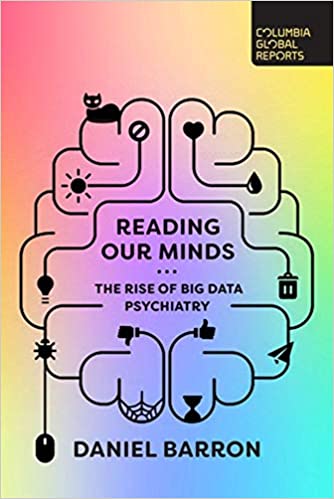Reading Our Minds: New book issues strong call to action to modernize psychiatry
 The Rise of Big Data Psychiatry (The Wall Street Journal):
The Rise of Big Data Psychiatry (The Wall Street Journal):
As a physician, I need to figure out three things when a new patient walks into my office: what their life is typically like, what has changed that made them seek treatment and what I can do to help them. It’s a complex problem, and most fields of medicine approach it by taking measurements. If I were a cardiologist evaluating a patient’s chest pain, for instance, I would speak with the patient, but then I would listen to their heart and measure their pulse and blood pressure. I might order an electrocardiogram or a cardiac stress test, tools that weren’t available a century ago.
Because I’m a psychiatrist, however, I evaluate patients in precisely the same way that my predecessors did in 1920: I ask them to tell me what’s wrong, and while they’re talking I carefully observe their speech and behavior. But psychiatry has remained largely immune to measurement. At no point in the examination do I gather numerical data about the patient’s life or behavior, even though tools for taking such measurements already exist. In fact, you likely are carrying one around in your pocket right now. Keep reading essay HERE, adapted from the new book Reading Our Minds: The Rise of Big Data Psychiatry by psychiatrist Daniel Barron.
Relevant Study:
A machine learning approach predicts future risk to suicidal ideation from social media data (NPJ Digital Medicine). From the Abstract:
- Machine learning analysis of social media data represents a promising way to capture longitudinal environmental influences contributing to individual risk for suicidal thoughts and behaviors. Our objective was to generate an algorithm termed “Suicide Artificial Intelligence Prediction Heuristic (SAIPH)” capable of predicting future risk to suicidal thought by analyzing publicly available Twitter data. We trained a series of neural networks on Twitter data queried against suicide associated psychological constructs including burden, stress, loneliness, hopelessness, insomnia, depression, and anxiety. Using 512,526 tweets from N?=?283 suicidal ideation (SI) cases and 3,518,494 tweets from 2655 controls, we then trained a random forest model using neural network outputs to predict binary SI status. The model predicted N?=?830 SI events derived from an independent set of 277 suicidal ideators relative to N?=?3159 control events in all non-SI individuals with an AUC of 0.88 (95% CI 0.86–0.90). Using an alternative approach, our model generates temporal prediction of risk such that peak occurrences above an individual specific threshold denote a ~7 fold increased risk for SI within the following 10 days … We validated our model using regionally obtained Twitter data and observed significant associations of algorithm SI scores with county-wide suicide death rates across 16 days in August and in October, 2019, most significantly in younger individuals. Algorithmic approaches like SAIPH have the potential to identify individual future SI risk and could be easily adapted as clinical decision tools aiding suicide screening and risk monitoring using available technologies.
News in Context:
- Machine learning study finds standardized brain scan biomarker to detect depression with 66% accuracy
- Alphabet’s X shares Amber EEG system to expand the quest for mental health biomarkers
- Machine-learning study finds EEG brain signatures that predict response to antidepressant treatments
- A call to action: We need the right incentives to guide ethical innovation in neurotech and healthcare
- New report: Empowering 8 Billion Minds via Ethical Development and Adoption of Neurotechnologies


